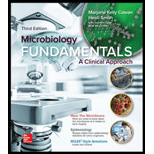
Microbiology Fundamentals: A Clinical Approach
3rd Edition
ISBN: 9781259709227
Author: Marjorie Kelly Cowan Professor, Heidi Smith
Publisher: McGraw-Hill Education
expand_more
expand_more
format_list_bulleted
Concept explainers
Question
Chapter 20.3, Problem 7AYP
Summary Introduction
To discuss: The important features of two categories of oral conditions: dental caries and periodontal diseases.
Introduction:
Infections or diseases refer to an abnormal condition of body that disrupts important physical and physiological function of body. Disease is caused by improper diet, lack of exercise, various infectious agents that are present in nature, toxic substances, genetic disorders, and depression, stress that play role in illness and disturbs normal functioning of body.
Expert Solution & Answer
Want to see the full answer?
Check out a sample textbook solution
Students have asked these similar questions
How do I determine the inhertiance pattern from the pedigree diagram?
its an open book assignemnt
Describe two different gene regulation mechanisms involving methylation
Chapter 20 Solutions
Microbiology Fundamentals: A Clinical Approach
Ch. 20.1 - Prob. 1AYPCh. 20.1 - List the natural defenses present in the...Ch. 20.1 - Prob. 1NPCh. 20.2 - List the types of normal biota presently known to...Ch. 20.2 - Describe how our view has changed of normal biota...Ch. 20.3 - List the possible causative agents, modes of...Ch. 20.3 - Prob. 6AYPCh. 20.3 - Prob. 7AYPCh. 20.3 - Identify the most important features of mumps,...Ch. 20.3 - Differentiate among the main types of hepatitis,...
Ch. 20.3 - Prob. 1MMCh. 20.3 - Prob. 2NPCh. 20.3 - Prob. 3NPCh. 20.3 - Q. Why are the effects of jaundice so widespread...Ch. 20.3 - Prob. 4NPCh. 20.4 - Prob. 10AYPCh. 20.4 - Prob. 11AYPCh. 20.4 - Prob. 12AYPCh. 20.4 - Prob. 5NPCh. 20 - Prob. 1QCh. 20 - Healthy teeth are important for good nutrition and...Ch. 20 - Prob. 3QCh. 20 - Prob. 4QCh. 20 - Why is heating food contaminated with...Ch. 20 - Prob. 6QCh. 20 - Prob. 7QCh. 20 - Prob. 8QCh. 20 - Prob. 9QCh. 20 - Prob. 10QCh. 20 - Why is it thought that the Shiga toxin in...Ch. 20 - Prob. 12QCh. 20 - Prob. 13QCh. 20 - Prob. 14QCh. 20 - Prob. 15QCh. 20 - Prob. 16QCh. 20 - Describe the populations that are most at risk for...Ch. 20 - Prob. 18QCh. 20 - Prob. 19QCh. 20 - Prob. 20QCh. 20 - Prob. 21QCh. 20 - From chapter 11, figure 11.2a. Imagine for a...
Knowledge Booster
Learn more about
Need a deep-dive on the concept behind this application? Look no further. Learn more about this topic, biology and related others by exploring similar questions and additional content below.Similar questions
- What is behavioral adaptarrow_forward22. Which of the following mutant proteins is expected to have a dominant negative effect when over- expressed in normal cells? a. mutant PI3-kinase that lacks the SH2 domain but retains the kinase function b. mutant Grb2 protein that cannot bind to RTK c. mutant RTK that lacks the extracellular domain d. mutant PDK that has the PH domain but lost the kinase function e. all of the abovearrow_forwardWhat is the label ?arrow_forward
- Can you described the image? Can you explain the question as well their answer and how to get to an answer to an problem like this?arrow_forwardglg 112 mid unit assignment Identifying melting processesarrow_forwardGive only the mode of inheritance consistent with all three pedigrees and only two reasons that support this, nothing more, (it shouldn't take too long)arrow_forward
- Oarrow_forwardDescribe the principle of homeostasis.arrow_forwardExplain how the hormones of the glands listed below travel around the body to target organs and tissues : Pituitary gland Hypothalamus Thyroid Parathyroid Adrenal Pineal Pancreas(islets of langerhans) Gonads (testes and ovaries) Placentaarrow_forward
- What are the functions of the hormones produced in the glands listed below: Pituitary gland Hypothalamus Thyroid Parathyroid Adrenal Pineal Pancreas(islets of langerhans) Gonads (testes and ovaries) Placentaarrow_forwardDescribe the hormones produced in the glands listed below: Pituitary gland Hypothalamus Thyroid Parathyroid Adrenal Pineal Pancreas(islets of langerhans) Gonads (testes and ovaries) Placentaarrow_forwardPlease help me calculate drug dosage from the following information: Patient weight: 35 pounds, so 15.9 kilograms (got this by dividing 35 pounds by 2.2 kilograms) Drug dose: 0.05mg/kg Drug concentration: 2mg/mLarrow_forward
arrow_back_ios
SEE MORE QUESTIONS
arrow_forward_ios
Recommended textbooks for you
 Medical Terminology for Health Professions, Spira...Health & NutritionISBN:9781305634350Author:Ann Ehrlich, Carol L. Schroeder, Laura Ehrlich, Katrina A. SchroederPublisher:Cengage Learning
Medical Terminology for Health Professions, Spira...Health & NutritionISBN:9781305634350Author:Ann Ehrlich, Carol L. Schroeder, Laura Ehrlich, Katrina A. SchroederPublisher:Cengage Learning- Essentials of Pharmacology for Health ProfessionsNursingISBN:9781305441620Author:WOODROWPublisher:Cengage


Medical Terminology for Health Professions, Spira...
Health & Nutrition
ISBN:9781305634350
Author:Ann Ehrlich, Carol L. Schroeder, Laura Ehrlich, Katrina A. Schroeder
Publisher:Cengage Learning




Essentials of Pharmacology for Health Professions
Nursing
ISBN:9781305441620
Author:WOODROW
Publisher:Cengage
How stress affects your body - Sharon Horesh Bergquist; Author: TED-Ed;https://www.youtube.com/watch?v=v-t1Z5-oPtU;License: Standard Youtube License